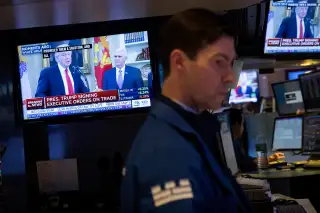Trump Was Supposed to Be Good for Stocks. Now Investors Aren't So Sure

The Dow is at a record high, but fund investors may be souring on the market rally.
At first glance, the stock market appears to be on a roll. Despite relatively slow U.S. economic growth, the benchmark Dow Jones average closed at a record 21,271.97 Friday (although stocks then slipped back 0.17% Monday). The broader S&P 500 is also near all-time highs, although it has softened after peaking on June 2.
But new data suggests that fund investors -- a group that largely consists of middle-American retirement savers -- have cooled significantly on stocks in recent weeks.
After pouring money into U.S. stocks following in the months following President Trump's surprise victory last November, investors changed course during May, yanking more than $2 billion net from domestic stock mutual funds and ETFs. While that total represents a tiny portion of the more than $7 trillion these funds hold, it was the first time since November that investors have pulled more money out of the market than they've put in, according to data from fund researcher Morningstar.
There are, of course, plenty of reasons for investors to be cautious. The market is up more than 33% since February 2016, the last time there was a significant price drop, according to Bespoke Investment Group. At 477 days long, this latest rally ranks as the 11th longest since 1928, before the Great Depression.
Pros have been warning for years that stocks look pricey relative to companies' underlying profits for years. For most of 2016, stocks traded between 24 and 27 times companies' average profits over the past decade, well above their historical average of 17 times. But with the Dow up roughly 16% since November 8, those valuations have kicked into overdrive; stocks now trade at roughly 30 times the past decade's earnings.
What's more, while Trump's victory was greeted by investor euphoria, the president's honeymoon may be near its end. Trump's approval rating, initially as high as 45%, has slipped into the 30s, as the tax cuts and and infrastructure plan that investors had pined for languish. The economy has continued to expand, adding, on average, 121,000 jobs over the past three months -- but that's below the 181,000 average over the past year.
Investors "have a somewhat muted enthusiasm at this point, says Dallas financial planner Clark Randall. "The rhetoric of the election is a distant memory and now the promises need to be fulfilled."
That ambivalence appears to be reflected in the latest fund data. Fund investors spent most of 2016 in a bearish mood, pulling a net $72 billion, in total, from U.S. stock mutual funds and ETFs during the first 10 months of the year. That sentiment changed dramatically in the wake of Trump's victory, however, with investors pouring $20 billion into U.S. stock funds in November and another $27 billion in December.
After an $11 billion net inflow in March, total fund inflow shrank to just $127 million in April, according to Morningstar data -- and for May, investors pulled out a net $2.3 billion. In ETFs alone, investors put in a total of $700 million -- the smallest net ETF inflow since February 2016. (The May totals exclude inflow into two Janus mutual funds, which were the result of fund mergers.)
To be sure, fund flows can be volatile, especially for ETFs. That's because in addition to being a vehicle for individual investors, ETFs are frequently used by hedge funds and pension funds.
And investors looking at fund flows as tea leaves should take heed: Academic literature has long shown that fund investors' attitudes are typically backward-looking, and usually fail to predict the future direction of the stock market.